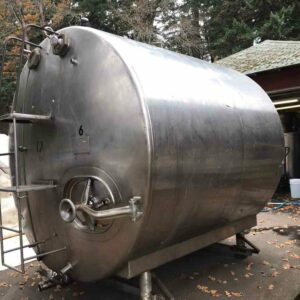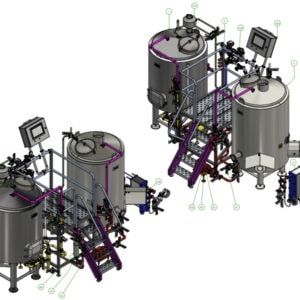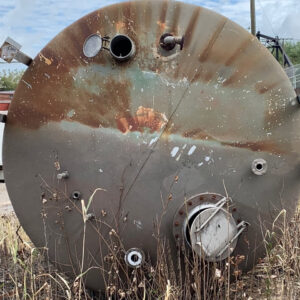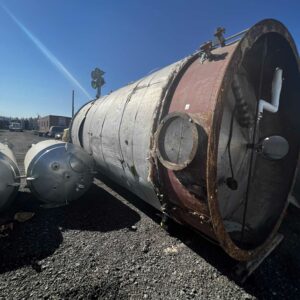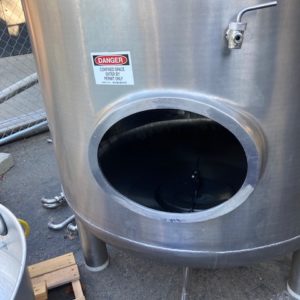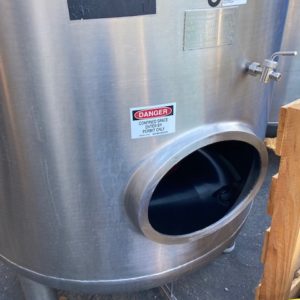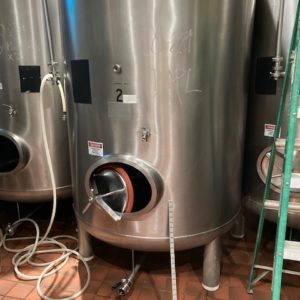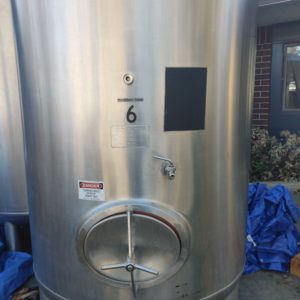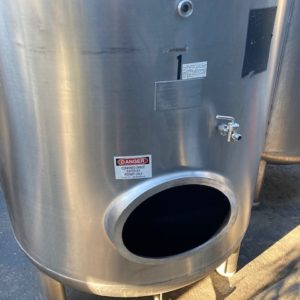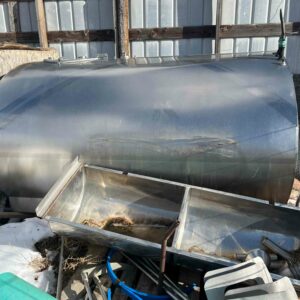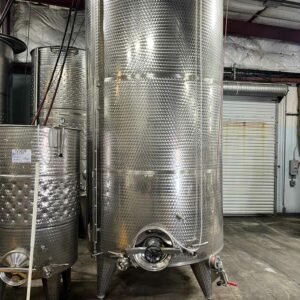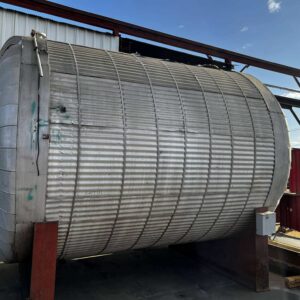Used Tanks For Sale
Revelation Machinery sells storage and process tanks with material construction of stainless steel, carbon steel, polyethylene, and fiberglass, typically ranging from 500 gallons to 40,000 gallons. Sometimes we may have used industrial tank listings outside of these parameters. Check back often for new arrivals, and subscribe to our mailing list for updates.
If you don’t find the tank you are looking for, please contact us! Revelation Machinery can always help you find what you need! If you have any questions about tanks or need to find a specific brand/type, please feel free to contact us! Interested in selling your equipment? Find out how to sell your used tanks to Revelation Machinery today!
Used tanks for sale include:
Stainless Steel Tanks
Found Results
Industrial storage tanks and process tanks
Industrial storage tanks vary in size, shape, material, and use. Oil, gas, fuel, water, hot water, and other chemicals stored in these containers require different specifications. Additionally, industrial storage tanks sometimes have requirements beyond static storage, including processing, mixing, and transportation. Tanks used beyond static storage or “holding” are often called process tanks.
The end-use of an industrial tank is critical in determining its specifications. In food and pharmaceuticals, the inner wall roughness is essential. Heating, cooling, and insulation may be vital for some applications. Sometimes a tank may require an agitator for mixing. Maybe the inner tank will be exposed to corrosive chemicals and require a more robust material and fabrication process. These factors account for the large array of industrial tanks outlined below.
Industrial Tank Material Construction
Stainless Steel Tanks: Stainless steel tanks are known for their non-corrosive properties. These tanks are ideal for storing or processing chemicals, livestock feed, and water.
Carbon Steel: The strength and durability of carbon steel are its main benefits. Unfortunately, extreme temperature changes can cause tank damage. Additionally, carbon steel tanks are apt to rust and corrode. Coatings or linings on the inside of the tank can combat corrosion but may not be suitable for all applications.
Polyethylene (Plastic): The significant benefits of plastic tanks are recyclability, non-corrosive, lightweight, and no joints or seams. Sometimes polyethylene tanks are translucent, allowing users to see internal levels. It is important to note that solvents and petroleum products can cause plastic tanks to degrade quickly.
Fiberglass (FRP): Also resistant to corrosion, these tanks are lightweight, competitively priced, and are usable above ground or underground. They are water-tight, which makes fiberglass FRP tanks ideal for leak-free applications.
Industrial Tank Sizes
Another major variant among tanks is the shape and size. Cylindrical, cone bottom/conical, open-top, and stackable rectangle tanks are all common and serve different purposes. A 145 feet diameter, 25 feet high tank can hold 2.87 million gallons, while a 2 feet x 1.5′ x 1.5′ domed, flat bottom plastic storage tank holds 16 gallons. Revelation Machinery’s used industrial tank offerings typically range from 500 gallons – 40,000 gallons.
Additional Industrial Tank Terminology
Jacketed Tanks: The purpose of a tank jacket is to regulate the temperature of the contents to keep them hot or cold. Jackets can occupy a small part of a tank, divided into zones, or cover the entire tank’s surface. Types of tank jackets include conventional, half-pipe coil, dimple, and plate coil jackets.
Double Wall Tanks: Tanks with double walls serve various purposes. When a second containment pan is required, a double-wall tank incorporates the outer tank wall as its containment pan. A different variation of a double-wall tank is manufactured with insulation between the tank walls to guard the contents of the inner tank against flame and fire.
Agitated Tanks: Process tanks used for mixing require an agitator to move the contained material. Tank mixer is an alternate name for an agitated tank, and both top and bottom entry agitators exist. Top agitators are more common and provide the benefit of a non-immersed seal. Mixing can occur continuously, in a batch, or both.
Tank heads: On cylindrical tanks, the top and bottom, or sides if the tank is horizontal, are called tank heads.
- Cone Bottom: A funnel-shaped tank head is called a cone bottom tank. When draining every last drop is critical, a cone bottom is the “go-to” in many industries. The agitator shaft in a mixing tank is longer than other bottom types, increasing costs. For this reason, dished bottoms, further explained in the next bullet point, are better for applications where both draining and mixing are required.
- Dished Bottom: The advantage is rigidity and better drainage than a flat bottom. The agitator length for mixers must be longer than a flat bottom, which increases the cost. Pressure ratings for dished tank heads are less than flat bottom tank heads.
- Slope Bottom: Since dish and cone bottom tanks have their drain located in the center, it can be hard to access the drainage outlet. A slope bottom tank allows drainage while positioning the drainage outlet on the outside of the tank for easier access.
- Flat Bottom: As reflected in its lower cost, this type of tank head is the easiest to manufacture. The length of the agitator shaft can be reduced in a mixing tank, lowering the cost. However, a flat bottom tank may be difficult to drain completely.
Tank Styles
There is a large variety of tanks, depending on the shape, size, use, and more. Some of the main types of tanks are:
- Vertical storage tanks: A vertical tank requires less floor space than its horizontal counterpart and can typically accommodate a larger storage volume.
- Horizontal tanks: These are suitable for transportation and are preferred over vertical tanks when height restrictions are a concern.
- Chemical feed stations: The primary use of these self-contained storage tanks is dispensing chemicals. Capacity ranges from 35 gallons to 550 gallons.
- Chemical injection tanks: Sometimes referred to as oil and gas chemical injection tanks and primarily used in the oil and gas industries, these tanks are available as round or rectangular in capacities of 65 to 725 gallons.
- Open-top tanks: Available in cylindrical and rectangular options, these tanks are also called dipping tanks, chroming tanks, batch tanks, and mixing tanks.
- Stackable lube and DEF (Diesel Exhaust Fluid) tanks: When floor space is a concern, stackable tanks are an ideal solution. These tanks are a cleaner alternative to traditional oil drums.
- Industrial water storage tanks: In addition to storing water, these tanks may hold DEF, liquid fertilizer, and other chemicals. Several materials makeups include Polyethylene, FRP, Carbon Steel, and Stainless Steel.
- Industrial leg tanks: UV inhibitors make these tanks ideal for indoor and outdoor use, and the tanks can be mounted to vehicles to transport liquid contents.
- Industrial IBC totes: Intermediate bulk containers or IBC tanks are alternate names for these tanks that transport or store both dry and liquid.
- Chemical blending tanks: These agitated tanks blend their contents and are also called Chemical Mixing Tanks.
- Food processing tanks: Food-grade tanks must remain sanitary and retain food quality and safety.
- Pharmaceutical tanks: The production process for tanks used in pharmaceuticals requires higher quality standards due to the standards and regulations of the industry.

